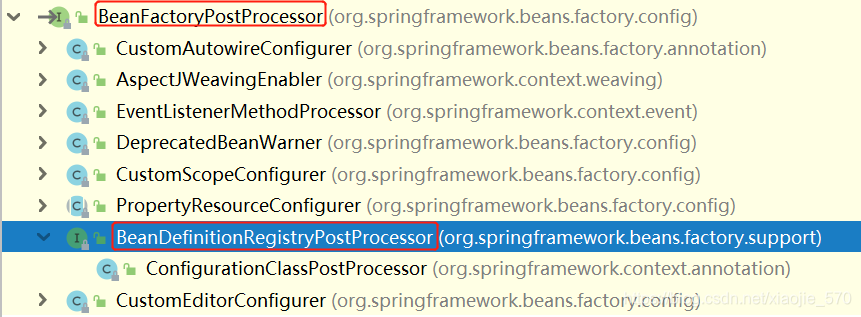上一篇:9-Spring源码解析之refresh(3)——【prepareBeanFactory】与【postProcessBeanFactory】
上篇文章讲的是refresh方法中调用的第三个方法prepareBeanFactory和第四个方法postProcessBeanFactory,
本篇文章我们来接着介绍refresh的第五个方法,也是非常重要的方法:invokeBeanFactoryPostProcessors(beanFactory);
1. 【AbstractApplicationContext】# invokeBeanFactoryPostProcessors
根据方法的名称,我们可以看出该方法的功能是执行BeanFactory的后置处理器。那么我们了解一下BeanFactoryPostProcessor的结构,对它有一个全局的认识。

我们可以看到BeanFactoryPostProcessor是一个接口,下面又很多实现类,还有一个子接口:BeanDefinitionRegistryPostProcessor。
接下来我们具体看一下Spring是如何帮我们实现这个功能的。
在refresh方法中调用AbstractApplicationContext # invokeBeanFactoryPostProcessors方法
protected void invokeBeanFactoryPostProcessors(ConfigurableListableBeanFactory beanFactory) {
// 【1】调用PostProcessorRegistrationDelegate类的invokeBeanFactoryPostProcessors方法
PostProcessorRegistrationDelegate.invokeBeanFactoryPostProcessors(beanFactory, getBeanFactoryPostProcessors());
// Detect a LoadTimeWeaver and prepare for weaving, if found in the meantime
// (e.g. through an @Bean method registered by ConfigurationClassPostProcessor)
if (beanFactory.getTempClassLoader() == null && beanFactory.containsBean(LOAD_TIME_WEAVER_BEAN_NAME)) {
beanFactory.addBeanPostProcessor(new LoadTimeWeaverAwareProcessor(beanFactory));
beanFactory.setTempClassLoader(new ContextTypeMatchClassLoader(beanFactory.getBeanClassLoader()));
}
}
从上面代码标注【1】的部分是实现该方法的核心,我们可以看到该方法是通过调用PostProcessorRegistrationDelegate类的invokeBeanFactoryPostProcessors方法实现的。注意这个类PostProcessorRegistrationDelegate,这个方法是执行BeanFactory的后置处理器,在后面的文章中可以看到在执行Bean的后置处理器的时候还会接触和使用到该类。
【1】处首先调用了当前类的getBeanFactoryPostProcessors方法,然后将方法返回值作为参数传入到PostProcessorRegistrationDelegate.invokeBeanFactoryPostProcessors中。
private final List<BeanFactoryPostProcessor> beanFactoryPostProcessors = new ArrayList<>();
public List<BeanFactoryPostProcessor> getBeanFactoryPostProcessors() {
return this.beanFactoryPostProcessors;
}
从上一篇文章2.节可以知道,本项目没有重写postProcessorBeanFactory方法,因此这里获取到的beanFactoryPostProcessors实际上是空值,因此传入到PostProcessorRegistrationDelegate.invokeBeanFactoryPostProcessors中的第二个参数值为空ArrayList。第一个参数值为我们之前获取到的beanFactory。为了防止忘记,我再贴一下当前的beanFactory中包含哪些beanDefinition。

上述图片中可以看出有6个beanDefinition,这6个beanDefinition实际上分两类:
- 第一类:内置的
beanDefinition- 前五个为内置的
beanDefinition,它们是Spring给我们内置的bean后置处理器
- 前五个为内置的
- 第二类:项目中的配置类
- 最后一个
mainConfig_AOP为和Bean定义有关的beanDefinition,它是我们项目中的配置类。
- 最后一个
另外,注意,这几个内置(internal)处理器的类型:详情参见:4-Spring容器创建之this()(1)——AnnotatedBeanDefinitionReader中的3.4节
internalConfigurationAnnotationProcessor的类型为:ConfigurationClassPostProcessorinternalAutowiredAnnotationProcessor的类型为:AutowiredAnnotationBeanPostProcessorinternalCommonAnnotationProcessor的类型为:CommonAnnotationBeanPostProcessorinternalEventListenerProcessor的类型为:EventListenerMethodProcessorinternalEventListenerFactory的类型为:DefaultEventListenerFactory
下面我们进入到PostProcessorRegistrationDelegate类的invokeBeanFactoryPostProcessors方法中看一下它究竟是如何实现的。
2. 【PostProcessorRegistrationDelegate】# invokeBeanFactoryPostProcessors
这个方法的方法体很长,需要有十足的耐心才能读完。而且该方法不只做了一件事情,而是做了三件事情。
public static void invokeBeanFactoryPostProcessors(
ConfigurableListableBeanFactory beanFactory, List<BeanFactoryPostProcessor> beanFactoryPostProcessors) {
// Invoke BeanDefinitionRegistryPostProcessors first, if any.
Set<String> processedBeans = new HashSet<>();
//---------------------------------------------【功能一】--------------------------------------------------
// -----【1】----- 2.1 介绍
// 这个if方法判断结果为true,具体原因在2.1 详细介绍
if (beanFactory instanceof BeanDefinitionRegistry) {
BeanDefinitionRegistry registry = (BeanDefinitionRegistry) beanFactory;
// regularPostProcessors:装载普通的BeanFactoryPostProcessor
// registryProcessors: 装载和Bean定义有关的 BeanDefinitionRegistryPostProcessor
List<BeanFactoryPostProcessor> regularPostProcessors = new ArrayList<>();
List<BeanDefinitionRegistryPostProcessor> registryProcessors = new ArrayList<>();
// 在1.节 我们知道 beanFactoryPostProcessors 传过来的是空的ArrayList, 所以不走for循环
for (BeanFactoryPostProcessor postProcessor : beanFactoryPostProcessors) {
if (postProcessor instanceof BeanDefinitionRegistryPostProcessor) {
BeanDefinitionRegistryPostProcessor registryProcessor =
(BeanDefinitionRegistryPostProcessor) postProcessor;
registryProcessor.postProcessBeanDefinitionRegistry(registry);
registryProcessors.add(registryProcessor);
}
else {
regularPostProcessors.add(postProcessor);
}
}
//---------------------------------------------【功能二】--------------------------------------------------
// 下面就是开始执行Spring容器里面的PostProcessor
// 执行顺序:先执行实现了 PriorityOrdered 接口的, 再执行实现了 Ordered 接口的, 最后执行剩下的
List<BeanDefinitionRegistryPostProcessor> currentRegistryProcessors = new ArrayList<>();
// First, invoke the BeanDefinitionRegistryPostProcessors that implement PriorityOrdered.
// 下面按照类型获取 beanFactory 中的后置处理器
// 首先获取 BeanDefinitionRegistryPostProcessor 类型的后置处理器名字。
// 从1. 节可以看出当前 beanFactory 中属于BeanDefinitionRegistryPostProcessor类型的后置处理器为 internalConfigurationAnnotationProcessor
String[] postProcessorNames =
beanFactory.getBeanNamesForType(BeanDefinitionRegistryPostProcessor.class, true, false);
for (String ppName : postProcessorNames) {
if (beanFactory.isTypeMatch(ppName, PriorityOrdered.class)) {
// 执行到这里想要获取 beanFactory 中名字为ppName的Bean,
// 但是此时Spring中只有BeanDefinition,而没有真正的Bean, 所以获取不到会开始创建名字为 ppName 的Bean.
// 实际上在这里创建的 Bean 为 ConfigurationClassPostProcessor 类型的
// 该类型为处理@Configuration注解的类
currentRegistryProcessors.add(beanFactory.getBean(ppName, BeanDefinitionRegistryPostProcessor.class));
processedBeans.add(ppName);
}
}
// 排序
sortPostProcessors(currentRegistryProcessors, beanFactory);
registryProcessors.addAll(currentRegistryProcessors);
// 是把currentRegistryProcessors里面所有的处理器一个一个获取出来,然后执行每个处理器对应的postProcessBeanDefinitionRegistry,这个方法非常重要。
// 根据上面的代码可以知道属于BeanDefinitionRegistryPostProcessor类型的只有ConfigurationClassPostProcessor
// 因此invokeBeanDefinitionRegistryPostProcessors里面执行的是ConfigurationClassPostProcessor的postProcessBeanDefinitionRegistry方法
// -----【2】-----在下一篇文章中详细介绍这个非常重要的方法
invokeBeanDefinitionRegistryPostProcessors(currentRegistryProcessors, registry);
currentRegistryProcessors.clear();
// Next, invoke the BeanDefinitionRegistryPostProcessors that implement Ordered.
postProcessorNames = beanFactory.getBeanNamesForType(BeanDefinitionRegistryPostProcessor.class, true, false);
for (String ppName : postProcessorNames) {
if (!processedBeans.contains(ppName) && beanFactory.isTypeMatch(ppName, Ordered.class)) {
currentRegistryProcessors.add(beanFactory.getBean(ppName, BeanDefinitionRegistryPostProcessor.class));
processedBeans.add(ppName);
}
}
sortPostProcessors(currentRegistryProcessors, beanFactory);
registryProcessors.addAll(currentRegistryProcessors);
invokeBeanDefinitionRegistryPostProcessors(currentRegistryProcessors, registry);
currentRegistryProcessors.clear();
// Finally, invoke all other BeanDefinitionRegistryPostProcessors until no further ones appear.
boolean reiterate = true;
while (reiterate) {
reiterate = false;
postProcessorNames = beanFactory.getBeanNamesForType(BeanDefinitionRegistryPostProcessor.class, true, false);
for (String ppName : postProcessorNames) {
if (!processedBeans.contains(ppName)) {
currentRegistryProcessors.add(beanFactory.getBean(ppName, BeanDefinitionRegistryPostProcessor.class));
processedBeans.add(ppName);
reiterate = true;
}
}
sortPostProcessors(currentRegistryProcessors, beanFactory);
registryProcessors.addAll(currentRegistryProcessors);
invokeBeanDefinitionRegistryPostProcessors(currentRegistryProcessors, registry);
currentRegistryProcessors.clear();
}
//---------------------------------------------【功能三】--------------------------------------------------
// 执行BeanDefinitionRegistryPostProcessor的postProcessBeanFactory方法,
// 实际上是使用cgLib将配置类增强
// -----【3】-----这个方法也很重要,在下一篇文章中会详细讲解。
// 注意此处调用的是invokeBeanFactoryPostProcessors
// 上面【2】处调用的是 invokeBeanDefinitionRegistryPostProcessors
invokeBeanFactoryPostProcessors(registryProcessors, beanFactory);
invokeBeanFactoryPostProcessors(regularPostProcessors, beanFactory);
}
else {
// Invoke factory processors registered with the context instance.
invokeBeanFactoryPostProcessors(beanFactoryPostProcessors, beanFactory);
}
//---------------------------------------------【功能四】--------------------------------------------------
// Do not initialize FactoryBeans here: We need to leave all regular beans
// uninitialized to let the bean factory post-processors apply to them!
// 执行BeanFactoryPostProcessor
// 执行顺序:先执行实现了 PriorityOrdered 接口的, 再执行实现了 Ordered 接口的, 最后执行剩下的
// 下面的顺序与功能三的顺序一样,只是功能三做的是invokeBeanDefinitionRegistryPostProcessors 功能四做的是 invokeBeanFactoryPostProcessors
// 这里获取到Spring中两个BeanFactoryPostProcessor:internalEventListenerProcessor 和 internalConfigurationAnnotationProcessor
String[] postProcessorNames =
beanFactory.getBeanNamesForType(BeanFactoryPostProcessor.class, true, false);
// Separate between BeanFactoryPostProcessors that implement PriorityOrdered,
// Ordered, and the rest.
List<BeanFactoryPostProcessor> priorityOrderedPostProcessors = new ArrayList<>();
List<String> orderedPostProcessorNames = new ArrayList<>();
List<String> nonOrderedPostProcessorNames = new ArrayList<>();
for (String ppName : postProcessorNames) {
if (processedBeans.contains(ppName)) {
// skip - already processed in first phase above
}
else if (beanFactory.isTypeMatch(ppName, PriorityOrdered.class)) {
priorityOrderedPostProcessors.add(beanFactory.getBean(ppName, BeanFactoryPostProcessor.class));
}
else if (beanFactory.isTypeMatch(ppName, Ordered.class)) {
orderedPostProcessorNames.add(ppName);
}
else {
nonOrderedPostProcessorNames.add(ppName);
}
}
// First, invoke the BeanFactoryPostProcessors that implement PriorityOrdered.
sortPostProcessors(priorityOrderedPostProcessors, beanFactory);
invokeBeanFactoryPostProcessors(priorityOrderedPostProcessors, beanFactory);
// Next, invoke the BeanFactoryPostProcessors that implement Ordered.
List<BeanFactoryPostProcessor> orderedPostProcessors = new ArrayList<>(orderedPostProcessorNames.size());
for (String postProcessorName : orderedPostProcessorNames) {
orderedPostProcessors.add(beanFactory.getBean(postProcessorName, BeanFactoryPostProcessor.class));
}
sortPostProcessors(orderedPostProcessors, beanFactory);
invokeBeanFactoryPostProcessors(orderedPostProcessors, beanFactory);
// Finally, invoke all other BeanFactoryPostProcessors.
List<BeanFactoryPostProcessor> nonOrderedPostProcessors = new ArrayList<>(nonOrderedPostProcessorNames.size());
for (String postProcessorName : nonOrderedPostProcessorNames) {
nonOrderedPostProcessors.add(beanFactory.getBean(postProcessorName, BeanFactoryPostProcessor.class));
}
invokeBeanFactoryPostProcessors(nonOrderedPostProcessors, beanFactory);
// Clear cached merged bean definitions since the post-processors might have
// modified the original metadata, e.g. replacing placeholders in values...
beanFactory.clearMetadataCache();
}
以上,我将invokeBeanFactoryPostProcessors人为的分为四个功能,下面分别讲一下每个功能所作的事情:
-
【功能一】
- 执行
beanFactoryPostProcessors的postProcessBeanDefinitionRegistry。但是在1.节中也介绍过了,因为当前项目中没有传入BeanFactory,因此这里的for循环不会执行。
- 执行
-
【功能二】 创建
ConfigurationClassPostProcessor并解析@Configuration注解- 首先获取当前
beanFactory中所有BeanDefinitionRegistryPostProcessors类型的BeanDefinition,在1节中已经给出当前beanFactory只有7个BeanDefinition,而属于BeanDefinitionRegistryPostProcessors类型的只有一个:internalConfigurationAnnotationProcessor - 执行
BeanDefinitionRegistryPostProcessors类型的Bean的postProcessBeanDefinitionRegistry。按照顺序执行(PriorityOrdered->Ordered-> 剩下的) - 这里需要先从
beanFactory中获取BeanDefinitionRegistryPostProcessors类型的Bean,但是此时还没有,所以在这里Spring第一次创建了Bean,这个Bean的类型就是ConfigurationClassPostProcessor,这个Bean就是用来解析@Configuration注解的。 - 注册完
Bean后,开始执行这个Bean的postProcessBeanDefinitionRegistry方法,也就是上述标注【2】的部分,这个方法非常重要,实现的功能就是利用注册的ConfigurationClassPostProcessor来解析项目中的配置类,将配置类中的所有注解类都转换为beanDefinition,然后存储在beanFactory中。下篇文章具体讲解解析的过程。
- 首先获取当前
-
【功能三】
- 执行
ConfigurationClassPostProcessor的postProcessBeanFactory方法,目的是使用CGLIB增强我们的配置类。但是这里面还没有将beanFactory中的配置类替换为增强后的配置类。
- 执行
-
【功能四】
- 执行
BeanFactoryPostProcessor类型的Bean的postProcessBeanFactory。注意区分功能二中执行的是:BeanDefinitionRegistryPostProcessors类型的Bean的postProcessBeanDefinitionRegistry。
- 执行
2.1. beanFactory instanceof BeanDefinitionRegistry
在2.节的【1】处,if (beanFactory instanceof BeanDefinitionRegistry)判断条件结果为true,主要的原因如下:
我们传入的beanFactory是在refresh方法调用的第二个方法ConfigurableListableBeanFactory获取到的,而获取到的beanFactory类型实际上是DefaultListablebleBeanFactory类型,那么为什么这个类型的beanFactotry对象属于BeanDefinitionRegistry类型呢,主要是因为DefaultListableBeanFactory类的实现关系。
下面给出DefaultListableBeanFactory类的代码可以很明显的看到该类不仅实现了ConfigurableListableBeanFactory接口还实现了BeanDefinitionRegistry接口,所以自然上述if条件返回true。
public class DefaultListableBeanFactory extends AbstractAutowireCapableBeanFactory
implements ConfigurableListableBeanFactory, BeanDefinitionRegistry, Serializable
2.2. invokeBeanFactoryPostProcessors功能解惑
实际上在Spring中,这个invokeBeanFactoryPostProcessors方法更类似于一个模板方法,它拥有四个功能,其中第二个功能和第四个功能很有意思,都是调用BeanPostProcessor类型的方法,但是调用的方法是不同的,先在【功能二】中调用postProcessBeanDefinitionRegistry,后在【功能四】中调用postProcessBeanFactory。为什么会这样呢?
实际上从名字就可以看出来,postProcessBeanDefinitionRegistry是用来创建BeanDefinition的,而postProcessBeanFactory是用来处理BeanFactory的。另外postProcessBeanFactory是可以修改BeanDefinition的。为了确保在修改BeanDefinition之前所有的BeanDefinition都存在,所以要先执行postProcessBeanDefinitionRegistry后执行postProcessBeanFactory。
3. 总结
invokeBeanFactoryPostProcessors的功能
- 执行
beanFactoryPostProcessors的postProcessBeanDefinitionRegistry - 创建
ConfigurationClassPostProcessor并解析@Configuration注解 - 执行
BeanFactoryPostProcessor类型的Bean的postProcessBeanFactory
注意以上是将BeanDefinition都已经注册到了beanFactory中,还没有开始创建Bean,但是通过上述分析,我们知道,其实也创建了两个Spring的内部使用的Bean:ConfigurationClassPostProcessor 和 EventListenerMethodProcessor。
下一篇文章会具体讲解两个问题:
-
invokeBeanDefinitionRegistryPostProcessors(currentRegistryProcessors, registry);(PriorityOrdered)ConfigurationClassPostProcessor类如何解析@Configuration注解类
-
invokeBeanFactoryPostProcessors(registryProcessors, beanFactory);ConfigurationClassPostProcessor类如何增强配置类
